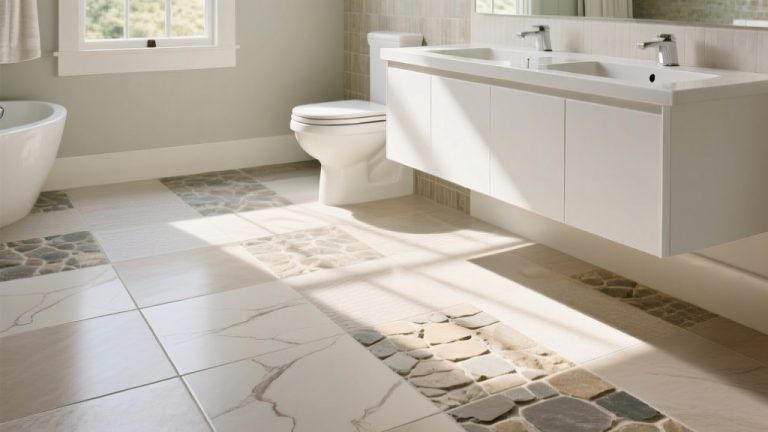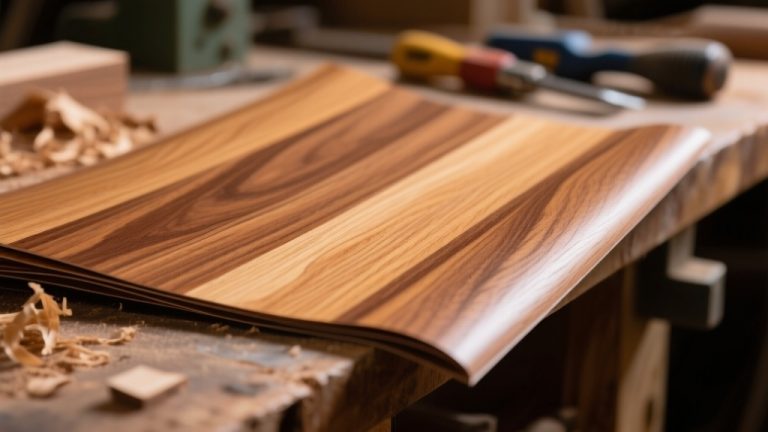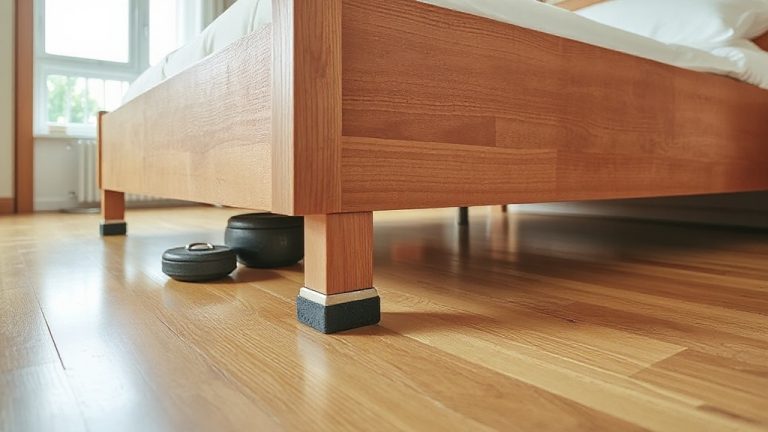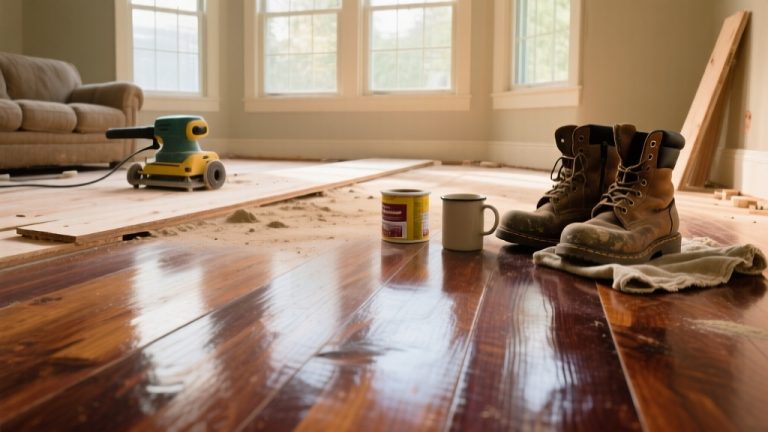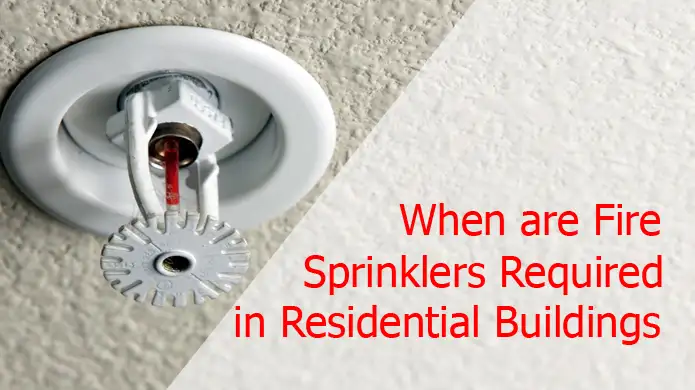Hardwood laminate flooring combines a high-density fiberboard core with a photographic wood-grain layer sealed beneath a durable wear surface, replicating the look of real hardwood.
You’ll appreciate its scratch resistance, moisture stability, and cost-effectiveness compared to traditional hardwood. Installation is straightforward with click-lock systems, and it offers versatile styles and fade-resistant finishes.
While it can’t be refinished like solid wood, it provides long-lasting performance with proper care. Exploring further reveals its installation nuances, environmental impacts, and maintenance tips.
Key Takeaways
- Hardwood laminate flooring is a multi-layered synthetic product designed to mimic the appearance of real hardwood wood grain.
- It features a high-density fiberboard core with a printed decorative layer sealed by a durable wear layer.
- Laminate flooring offers greater scratch, stain, and moisture resistance compared to traditional hardwood.
- Installation uses a click-lock system over an underlayment, requiring a level, dry subfloor and expansion gaps.
- It is a budget-friendly, low-maintenance alternative to solid hardwood with a lifespan of 15–30 years.
Definition and Composition of Hardwood Laminate Flooring
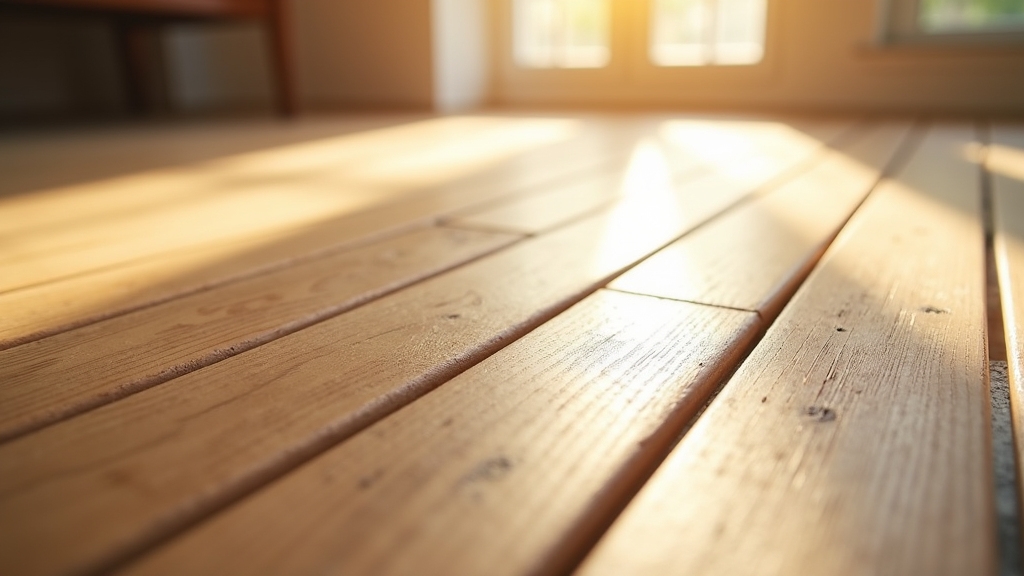
Although hardwood laminate flooring doesn’t incorporate real wood on its surface, it effectively mimics the look of natural hardwood through high-resolution photographic images of wood grain. Proper maintenance and cleaning are essential to preserve its appearance and durability over time.
You’ll find that this synthetic flooring product consists of multiple fused layers, combining cost-efficiency with durability. Its core typically uses High-Density Fiberboard (HDF) or Medium-Density Fiberboard (MDF), compressed and resin-treated for structural stability and moisture resistance.
The core layer provides strength and prevents warping, enhancing the flooring’s overall durability. The decorative layer features a printed wood grain image sealed beneath a transparent wear layer, protecting against scratches, stains, and UV damage.
Beneath it all, a backing layer made of melamine resin balances tension and prevents warping. This carefully engineered composition delivers the aesthetic appeal of hardwood with enhanced durability and moisture resistance, setting laminate apart from solid or engineered hardwood options.
Core Layers and Decorative Surfaces Explained
When you examine hardwood laminate flooring, the core layers and decorative surfaces form the foundation and visual identity of the product.
The core, typically high-density fiberboard (HDF) or medium-density fiberboard (MDF), is compressed with resin adhesives under heat and pressure. This process provides strength and stability. Its thickness, ranging from 6mm to 14mm, impacts durability and comfort.
Some advanced cores incorporate solid wood composites for enhanced resilience. Choosing the right core type contributes to the floor’s overall durability and performance. Above the core lies the decorative layer, which features high-resolution photographic images of natural materials like wood grain.
This layer is impregnated with melamine resin for durability and fade resistance. The decorative layer is one of several layers fused during manufacturing to form a durable plank. This layer determines the floor’s style, color, and texture, closely mimicking authentic hardwood.
Advantages of Hardwood Laminate Flooring Over Traditional Options
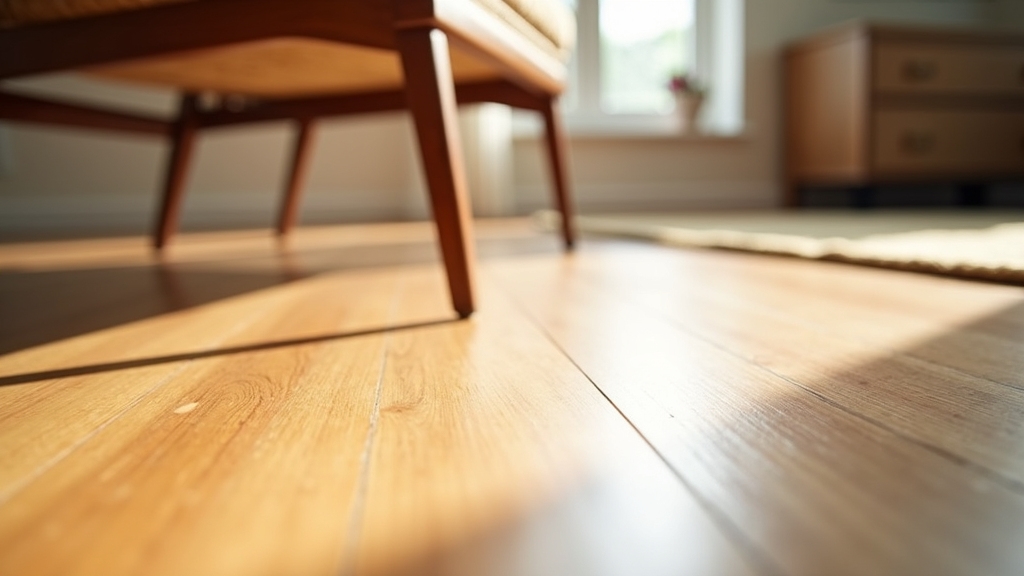
Hardwood laminate flooring is a fantastic option if you’re looking for something budget-friendly. It really combines lower material and installation costs with impressive durability. You won’t have to worry as much about scratches, stains, or moisture—definitely a win for busy homes or offices!
Additionally, its construction often allows for moisture resistance, making it less susceptible to water damage compared to traditional hardwood. Plus, let’s talk about design. Laminate gives you the flexibility to mimic a variety of natural looks while maintaining consistent, fade-resistant finishes.
This means you can find something that fits perfectly with your interior style, no matter what it is. Additionally, the click-lock system makes installation straightforward, often allowing for quick and easy DIY projects without professional help.
Cost-Effective Durability
Because laminate flooring incorporates a synthetic wear layer with substantial thickness and aluminum oxide reinforcement, it delivers superior scratch and abrasion resistance compared to traditional hardwood.
This wear layer, often 20 mils or thicker, markedly extends the floor’s functional life, with high-quality laminate lasting 15–30 years under proper care. Wear layer thickness is a critical factor in laminate’s durability, with residential grades typically between 12-20 mils and commercial grades exceeding 20 mils.
Transition strips such as the Tile-to-Laminate Transition allow for smooth connections when pairing laminate with other flooring materials. You’ll also appreciate laminate’s enhanced moisture resistance, thanks to sealed edges and synthetic layers, making it less prone to warping than hardwood in humid environments.
From a cost perspective, laminate reduces both upfront and maintenance expenses since it doesn’t require refinishing like hardwood. If damage occurs, replacing individual planks is more economical than hardwood repairs.
Design Versatility
Although traditional hardwood offers timeless charm, hardwood laminate flooring excels in design versatility by providing a broader spectrum of styles, textures, and finishes that closely replicate natural materials like wood, stone, and tile. Its construction with multiple layers provides enhanced durability and stability compared to traditional hardwood.
You can choose from various textures, glossy, matte, or embossed, that align with your décor. Laminate mimics numerous hardwood species’ finishes, expanding customization options.
Its color palette is extensive, ensuring seamless integration with your interior elements. Pattern options range from traditional wood grains to exotic designs, enhancing aesthetic appeal. Laminate is also known for being more water-resistant than hardwood, making it practical for various environments.
Advanced printing technology delivers realistic wood grain patterns and textures, achieving visual depth and authenticity. Additionally, laminate offers contemporary stone and tile looks uncommon in traditional hardwood, allowing you to tailor your space precisely to your design vision while maintaining professional-grade quality and durability.
Comparison Between Hardwood Laminate and Solid Hardwood Flooring
When comparing hardwood laminate and solid hardwood flooring, understanding their fundamental composition is essential. Solid hardwood is milled from natural wood, offering authentic grain, texture, and the ability to refinish multiple times, extending its lifespan up to 100 years.
Proper care, including moisture management, is crucial to preserving its longevity. Solid hardwood features genuine grain and texture and can be refinished multiple times, lasting up to a century.
In contrast, laminate consists of synthetic layers over a composite core, simulating wood appearance via photographic prints but lacking genuine texture and refinishing capacity. Laminate contains resin and petroleum-based materials, contributing to its synthetic nature and environmental impact.
Laminate provides superior moisture resistance and easier scratch protection but typically lasts 15 to 25 years before requiring plank replacement. Solid hardwood delivers a warmer underfoot feel, superior durability against dents, and develops unique patina over time.
Economically, laminate is more affordable upfront and DIY-friendly, while hardwood represents a long-term investment with higher resale value, necessitating careful moisture management to maintain its integrity and appearance.
Installation Techniques and Required Materials
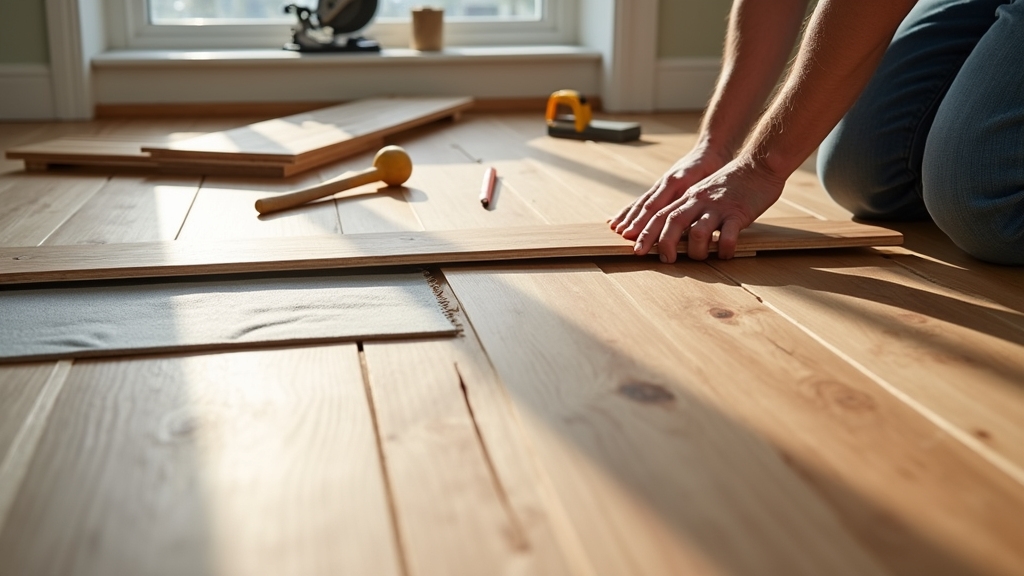
Before you begin installing hardwood laminate flooring, make certain the subfloor is meticulously prepared to provide a stable and level foundation.
Confirm it’s level within 3/16 inch over 10 feet, dry, clean, and free of obstructions like baseboards. It is essential to let flooring acclimate for at least 48 hours before installation to prevent issues after fitting due to floor expansion. Proper acclimation helps ensure consistent floor thickness and avoids uneven surfaces.
Next, install an appropriate underlayment flat, taping seams and avoiding overlaps to enhance moisture resistance and sound insulation. Here are the key steps and materials you’ll need:
- Gather essential tools: measuring tape, saw, tapping block, pull bar, spacers, hammer, and safety gear.
- Start installation from the longest wall, maintaining a 3-10 mm expansion gap with spacers.
- Lock planks by clicking short sides first, then long sides, staggering joints by at least 30 cm to create a more stable and visually appealing floor.
- Use precise cuts around obstacles, employing a pull bar to close gaps without glue or nails.
Environmental Impact and Health Considerations
Because hardwood laminate flooring involves multiple stages from raw material sourcing to installation, its environmental impact and health implications warrant careful evaluation.
You’ll find that sustainable forest certifications like FSC and SFI help guarantee responsible harvesting of wood fibers, often derived from fast-growing species or recycled by-products, reducing deforestation risks.
However, some sources remain less regulated, so it is important to verify certification to ensure responsible harvesting practices. From a health perspective, traditional laminate flooring may emit formaldehyde-based VOCs, but compliance with CARB Phase 2 standards and the use of low-emission adhesives mitigate indoor air quality concerns.
Additionally, choosing finishes and adhesives that are low in VOCs can further improve indoor environmental quality. Production demands high energy input, mainly from fossil fuels, and overseas manufacturing increases transportation emissions.
Careful planning and timing in installation, such as refinishing floors before painting, can reduce dust and VOC exposure during home improvement projects. Though laminate cores absorb some carbon during tree growth, disposal challenges persist due to limited recycling and landfill accumulation.
Maintenance Tips for Longevity and Appearance
Understanding the environmental and health factors linked to hardwood laminate flooring highlights the importance of proper upkeep to preserve both its appearance and durability.
You should implement a rigorous maintenance routine that minimizes damage and extends floor life:
- Sweep or vacuum regularly with soft-bristle tools to prevent abrasive grit from scratching surfaces. Applying fire retardant treatments to nearby wooden structures can also enhance overall safety in your home.
- Address spills immediately using microfiber cloths to avoid moisture infiltration and staining.
- Select manufacturer-approved cleaners and avoid soap-based or oily products that cause delamination or void warranties.
- Protect floors with furniture pads, area rugs in high-traffic zones, and maintain stable indoor humidity to reduce plank expansion or contraction. Using a damp microfiber mop with laminate-specific cleaners ensures effective cleaning without excess water damage.
Repair and Replacement Strategies for Damaged Flooring
While minor scratches and surface imperfections can often be repaired with putty kits or wax filler sticks, more extensive damage may require plank replacement to restore the floor’s integrity.
Start by identifying irreparable planks, then carefully cut and remove them using a circular saw or utility knife. When using a saw, set the depth to match the laminate thickness to avoid damaging the subfloor or surrounding boards. Measure and cut replacement planks precisely, trimming the tongue as needed for a seamless fit.
Maintaining stable indoor humidity within the recommended 30%-50% range helps prevent further damage during repairs. Secure new planks with appropriate glue, tapping them into place with a hammer and buffer. For scratches, use color-matched putty or heat-applied wax filler sticks, then buff to smooth the surface.
Address lifting or buckling by checking subfloor moisture and levelness, adjusting expansion gaps, and replacing damaged planks. Employ vapor barriers and maintain humidity between 30%-50% to prevent future damage.
Frequently Asked Questions
Can Hardwood Laminate Flooring Be Installed Over Radiant Heating Systems?
Yes, you can install hardwood laminate flooring over radiant heating systems if you follow strict guidelines. Use laminate rated for radiant heat, maintain temperature limits around 85°F, and select low-thermal-resistance underlayments.
Install with floating methods and guarantee expansion gaps to accommodate thermal expansion. Proper thermostat control prevents overheating, while moisture barriers protect layers. These steps help preserve floor integrity, optimize heat transfer, and avoid warping or damage over time.
What Types of Furniture Pads Are Best for Laminate Flooring?
You don’t want your laminate floor scratched by harsh furniture legs, yet you need stability under heavy pieces. Felt furniture pads are your best bet. They’re soft, made from recycled fibers, and have strong adhesive to protect surfaces while letting furniture glide smoothly.
Avoid rubber pads for most laminate floors since they can trap moisture or cause damage. Always guarantee pads adhere firmly by waiting a few minutes before replacing furniture on them.
How Does Laminate Flooring Affect Home Resale Value?
Laminate flooring can positively influence your home’s resale value by offering a cost-effective upgrade that appeals to buyers seeking durable, easy-to-maintain surfaces. It typically increases home value by 3%–5%, enhancing market competitiveness.
While its ROI (78%–91%) is less than hardwood, laminate’s durability, water resistance, and aesthetic versatility make it attractive in move-in-ready homes. This is especially true in high-traffic areas, supporting quicker sales without extensive remodeling costs.
Are There Specific Cleaning Products to Avoid on Laminate Floors?
You’ll want to steer clear of “overenthusiastic” cleaners like wax, polish, or oil-based soaps. They leave sticky films and attract dirt. Avoid harsh abrasives and ammonia or bleach-based products since they scratch and dull the wear layer.
Also, skip excessive water and steam mops to prevent swelling. Acidic cleaners, especially vinegar, can erode the protective layer. Instead, use pH-neutral, professional cleaners designed specifically for laminate floors to keep them pristine.
Can Hardwood Laminate Flooring Be Used Outdoors or in Garages?
You shouldn’t use hardwood laminate flooring outdoors because moisture, temperature changes, and UV exposure cause warping and swelling. In garages, laminate isn’t ideal due to heavy loads, moisture, and potential scratches from tools or vehicles.
While some waterproof variants work in climate-controlled garages with proper moisture barriers, they still risk damage. For durability and longevity, specialized garage or outdoor flooring materials are a better choice than standard hardwood laminate.
Get the Hardwood Feel – Minus the Hassle of Refinishing
If you think hardwood laminate flooring is just a budget-friendly alternative, think again. It’s practically a superhero in disguise! With its multi-layered construction, easy installation, and impressive durability, it outperforms many traditional floors without breaking a sweat.
By choosing hardwood laminate, you’re not just picking a floor; you’re investing in a resilient, stylish surface that can withstand everything from spilled coffee to heavy foot traffic. All while staying eco-friendly and low-maintenance.

